South-east Queensland is generally defined as the area from the border with New South Wales in the south to Gympie in the north and Dalby in the west with it's largest city Brisbane rapidly joining the Gold Coast to make a large metropolitan area. The climate of the area is very pleasant for most of the year, temperatures rarely outside 10-30ºC and the bird-life prolific. There are a wide variety of habitats from mangrove and coastal sand-dunes to rainforest and dry interior woodland. In March 1991 our 'house' team took part in a 24-hour bird-race, scored 216 species and were still runners-up!
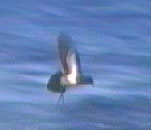
Seabirds
The area has an excellent seabird list, although one should visit the southern states in winter to be guaranteed albatross and Antarctic specialities. The following can all be found with varying degrees of certainty from Point Lookout, on North Stradbroke Island or by chartering a boat for the day from Manly or Southport and sailing approximately 20 kms into the Coral Sea past this point.
Yellow-nosed Albatross, Great-winged, Cape, Providence, Gould's, Tahiti, White-chinned and White-necked Petrel, various Prions and the following Shearwaters, Flesh-footed, Wedge-tailed, Buller's, Sooty, Short-tailed, Streaked, Hutton's and Fluttering. Wilson's, White-bellied and Black-bellied Storm-Petrel, Brown Booby, Australasian Gannet, Lesser Frigatebird, White and Red-tailed Tropicbirds, three species of Skua, Arctic, Pomarine and Long-tailed. Gulls are not well represented, with Silver Gull being the only abundant species, however both Dominican and Franklin's have shown up nearby at Redcliffe. Terns on the other hand are commonly seen and Sooty, Arctic, Common (of the Asian race longipennis), Little, White-fronted, White-winged, Crested and Lesser-crested have all been recorded. During the time I have been resident in the area I have seen all of the above there but in common with pelagic trips and sea-watches every-where they ranged from very exciting to very tedious.
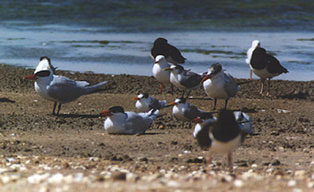
Herons, Cranes, Storks, Spoonbills and Ibis
All the Australian Egrets can be found in the area including Eastern Reef. White-faced and Striated Heron are common. White-necked (Pacific) Heron and Nankeen Night-Heron, Black-backed (formerly Little), Brown and Black Bittern are occasionally seen locally. Black-necked Storks breed annually and there are several pairs of Brolga resident in the suburbs. All Australian Ibis and Royal Spoonbill are common although the Yellow-billed Spoonbill is normally found in farmland to the west of the city.
Wildfowl
Around Brisbane there are many lakes and small dams where most of the wildfowl of Australia (with a few exceptions) can be found. In good years small numbers of Cotton Pygmy-Geese and Blue-billed and Freckled Duck are often present in the agricultural areas to the west of the city.
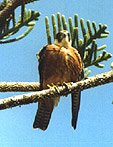
Raptors
South-east Queensland has an abundance of raptor species with Ospreys, Pacific Baza, Wedge-tailed Eagle and White-bellied Sea-Eagle, Whistling and Brahminy Kite, Grey and Brown Goshawk and Collared Sparrowhawk common and easily found within a few kilometres of the city-centre. Other birds of prey encountered fairly regularly are Square-tailed Kite, Little Eagle, Spotted and Swamp Harrier, Australian Hobby, Brown and Peregrine Falcon and Nankeen Kestrel.
Gamebirds
Various species of True-Quail and Button-Quail are found in the region, Brown Quail, Black-breasted and Painted Button-Quail are fairly easy to find whereas Red-backed and Red-chested Button-Quail, King and Stubble Quail rather less so.
Rails and Crakes
Most of the Australian Rails and Crakes can be found in this area (again, with a few exceptions) Some like Purple Swamphen, Dusky Moorhen and Eurasian Coot are ubiquitous, whereas Bush-hen, Australian Spotted, Spotless and Baillon's Crakes, Lewin's and Buff-banded Rail are present, but can be a real challenge and are usually easier in the summer months.
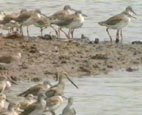
Waders and similar species
Just to the east of Brisbane and its suburbs is the large expanse of water and sheltered islands known as Moreton Bay, internationally acknowledged as one of the most important sites for wintering waders in Australia and the Pacific. The following are found in the area between September and April, and are common, Pacific Golden Plover, Mongolian and Greater Sand Plover, Ruddy Turnstone, Far Eastern Curlew, Whimbrel (eastern race), Grey-tailed and Wandering Tattler (the latter in small numbers on rocky headlands), Greenshank, Latham's (Japanese) Snipe, Black and Bar-tailed Godwit, Great and Red Knot, Red-necked Stint, Marsh, Curlew, Sharp-tailed and Terek Sandpiper and also regularly but in much smaller numbers Asiatic Dowitcher and Broad-billed Sandpiper. Other less long-distance migrants easily encountered are Red-necked Avocet, Double-banded Plover (April to August) Red-capped and Red-kneed Plover, Pied and rarely, Sooty Oystercatcher. Around, and in the suburbs it is possible to find Comb-crested Jacana, Bush and Beach Thick-knee (the latter on Moreton and Stradbroke Islands and the Gold Coast). Occasionally after rain the odd Painted Snipe puts in an appearance.
Pigeons and Doves
These are well represented in the area, rainforest pigeons are more frequent in summer in the D'aguilar Range, where Rose-crowned, Wompoo, Wonga, Brown, Emerald, Topknot and White-headed are fairly common. In the city introduced Spotted Turtle Doves and the native Crested Pigeon are abundant and in country areas Bar-shouldered and Peaceful Doves are readily found. However, to find Squatter Pigeon, Common and Brush Bronzewing one has to travel a little farther afield.
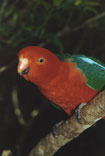
Parrots
Over one weekend I have found 15 species within a 4-hour drive from Brisbane. Glossy-Black, Yellow-tailed Black and Sulphur-crested Cockatoo, Galah, Cockatiel, Pale-headed and Eastern Rosella, Rainbow, Scaly-breasted, Musk and Little Lorikeet, King, Red-winged, Red-rumped and Turquoise Parrot. Ground Parrot can be found at Cooloolah National Park, 2 hours north and for the very keen Night Parrot, thought extinct for nearly a century, have recently been observed in far-western Queensland (approx 1000 kms from Brisbane!)
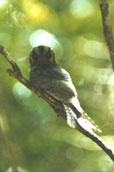
Nocturnal birds
White-throated Nightjar, Tawny Frogmouth, Powerful Owl and Southern Boobook can usually be found year-round within 5 minutes drive of the city-centre, and the two most sought-after birds of the area, Marbled Frogmouth and Sooty Owl may be tricky but can often be found in known sites in the rain-forest at Mt Mee, Mt Glorious, Conondale Range or Mt Tamborine. Owlet-Nightjar is more abundant than thought and can be found in a wide variety of habitats. Masked and Barking Owls are occasionally seen or heard but usually difficult to re-locate and are rare in this area.

Passerines and similar species
Cuckoos are well represented seasonally in the area, with Little, and Horsfield's Bronze, Brush, Channel-billed and Koel in the summer and throughout the year Shining Bronze, Fan-tailed Cuckoo and Pheasant Coucal, occasionally Pallid, Black-eared and Oriental pass through. Laughing Kookaburras are noisily abundant, from country areas to the city, other Kingfishers are also plentiful with Forest, Sacred, Azure and Collared (Mangrove) found throughout the area. Dollarbirds are summer visitors and Rainbow Bee-eaters common all year. Two species of migrant Swift can be seen in the area, White-throated Needletails are common in summer and Fork-tailed (Pacific) pass through on migration south. Four species of Australian hirundine occur in South-east Queensland, Welcome Swallow, Tree and Fairy Martin plus the endemic White-backed Swallow, usually in the agricultural areas west of the city known as the Darling Downs. A few of the areas specialities have restricted ranges, Albert's Lyrebird, Rufous Scrub-bird and Eastern Bristlebird are rather elusive and found at Lamington National Park, (the latter two possibly easier to find in NSW).
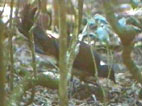
Noisy Pitta can be seen and heard in most rainforest areas in summer, although Superb Lyrebird is found only in Queensland in the 'Granite-belt' parks such as Girraween and Sundown near the NSW border.
Unfortunately in this state there is only one species of Pipit, Australian (or Richard's) and the Singing Bush-Lark is the only representative of the True Larks.
Cuckoo-shrikes are an interesting family and all species can be found in SE Queensland. Black-faced, Little and Varied Triller are fairly common, White-winged Triller and Cicadabird are summer visitors. Yellow-eyed are very nomadic relying on fruit-bearing trees and the strange Ground Cuckoo-Shrike found occasionally near Atkinson's Dam west of the city.
White's or Scaly Thrush in Australia has recently been split into two species, Bassian and Russet-tailed, although the only sure method of identification (apparently) is the call.
The Australian Robins are representative of the Old-world Flycatchers which becomes fairly evident when observing females of some species, the following are found in our area, Jacky Winter (White-tailed), Eastern Yellow, Pale Yellow, Hooded, Rose, Red-capped and rarely but usually in winter near Girraween NP, Scarlet and Flame Robin.
The Pachycephala or 'Thick-heads' are almost unique to the Australasian Region and are well-represented with Grey and Rufous Shrike-Thrush, Golden, Rufous and Olive Whistler and the rather unusual Crested Shrike-tit.
Another family which are found mainly in the South Pacific Region are the Monarch Flycatchers, most are summer visitors, Black-faced and Spectacled Monarch, Leaden Flycatchers and Rufous Fantail being particularly abundant, Grey Fantail and Willie-wagtail are probably the commonest and most widespread birds in the region. Whilst White-eared Monarch, Satin and Shining flycatchers are present but difficult to find.
There are several species with odd affinities, Southern Logrunner and Eastern Whipbird are 'skulkers' found in wet forest areas. Spotted Quail-Thrush have similar habits but are found on slopes in dry open forest and despite their notoriety for being 'difficult' species can be found within 10-15 minutes drive of Brisbane city-centre and are fairly easy around Dayboro.
Grey-crowned Babbler are the only common representative (but appear to be declining in the Greater Brisbane area) of this family in this region, although one need only to drive to northern NSW for White-browed, and South-west Queensland for Chestnut-crowned and the recently discovered Hall's Babbler.
Australia does not have a large number of 'Old-world' Warblers but most of those that are, can be found in SE Queensland. Australian (formerly Clamorous) Reed-Warbler, Tawny and Little Grassbird, Golden-headed (Bright-capped) Cisticola, Rufous and Brown Songlark (both ephemeral, common in some years, rare in others.)
When most people see a book on Australian birds for the first time they are invariably impressed by the brightly-coloured Fairy-Wrens (Maluridae), three of these being common in the region, Variegated, Superb and Red-backed. Southern Emu-Wren was recently discovered in Cooloolah National Park (approx.3 hours drive from Brisbane) but is still not easy to find!
Australian Warblers are a large group which includes Thornbills, Gerygones, Scrubwrens and others. Some taxonomic problems are evident (are Brown and Inland Thornbills the same species?) but there are about 7 Thornbills, 4 Gerygones, 3 Scrubwrens. Speckled Warbler, Weebill, Southern Whiteface and with difficulty in the 'Granite-belt', Chestnut-rumped Heath-wren.
Woodpeckers are replaced in the Australian region by Treecreepers, three are found in the area, White-throated by far the commonest, with Red-browed and Brown. Sitellas are small birds resembling Nuthatches, formerly there were 5 species, unfortunately for 'twitchers' these have all been 'lumped' into one, the Varied Sittella.
The Honeyeaters are an enormous family with representatives in South-east Asia and the South Pacific. Australia has approximately 67 and South-east Queensland about 30. These range from the ubiquitous Brown to the very rare Regent Honeyeater.
The Flowerpeckers are another large family of South-east Asian species with only one Australian representative, found throughout the region, the Mistletoebird. Two species which resemble Flowerpeckers but may or may not be related are the Spotted and Striated Pardalotes, these are very common in South-east Queensland. The Silvereye is the sole representative of the White-eyes, although various sub-species can be found in the region seasonally.
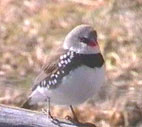
Seven species of Estrildid Finch are resident in the area, including one introduced, the Scaly-breasted Mannikin. One species, the Plum-headed Finch is frequently sought by overseas birders, unfortunately it's numbers have been much reduced by the cage-bird trade, and it is also highly nomadic, often found in western areas after heavy rain.
Figbirds, as there name suggests are fruit-eating birds, and can be found throughout the suburbs in large noisy flocks, whilst the Olive-backed Oriole is a more solitary bird, although it can still be found in good numbers throughout the region in summer.
Spangled Drongos are nomadic but normally present throughout the year in backyards in Brisbane, and they make good substitutes for alarm-clocks, if you need to arise before 0430 am!
Bowerbirds are unique to Australasia and quite well represented in SEQ, the stunning Regent Bowerbird can be seen at Lamington NP or Mt Glorious, along with Satin Bowerbird and Green Catbird. Spotted Bowerbird is a more western species but is occasionally encountered in the region.
Contemplating Birds of Paradise, most birders think of New Guinea, However one species inhabits the rain-forest areas of South-east Queensland and can quite easily be observed displaying to females in the breeding season, the male Paradise Riflebird choses a prominent perch and holds it's wings above it's head swaying from side to side and emits a strange loud rasping call.
Two rather odd species are common in the west of the region, the Apostlebird and White-winged Chough, both build mud-nests and form sociable flocks in common with the Babblers.
Wood-swallows are another family almost confined to Australia, two are common in the east of the area, White-breasted and Dusky, one the Black-faced is more westerly and the remaining three, White-browed, Masked and Little are ephemeral and turn up occasionally in the region.
Replacing Shrikes in Australia are the Butcherbirds, they also have the habit of impaling prey on spikes in bushes and barbed-wire, but are generally larger birds, Pied and Grey Butcherbirds being very common in the area. Closely related are the Australian Magpie and the Pied Currawong, common and having the habit of attacking humans near their nest without justification, the trick being never to turn your back on them, as apparently, they don't normally attack if they can see your eyes!
The last group of birds are the Corvids, probably the hardest group of birds to identify in the country at present, knowledge of calls is essential. Two species can be found in South-east Queensland, in the east Torresian Crow and further west the Australian Raven.
If you are planning a trip to Australia and decide a stop-over in this area sounds an attractive option please contact me on the address below and I should be able to arrange suitable accomodation, transport and guide facilities. Remember that over half the species found in Australia have been seen in South-East Queensland!
Tom & Marie Tarrant Lot 10 Watson
Rd Samsonvale Queensland 4520 Australia